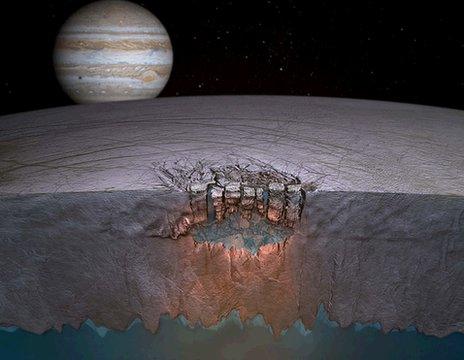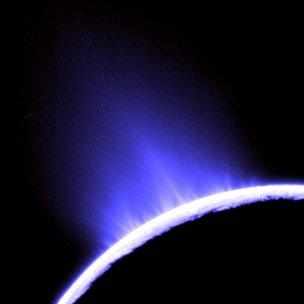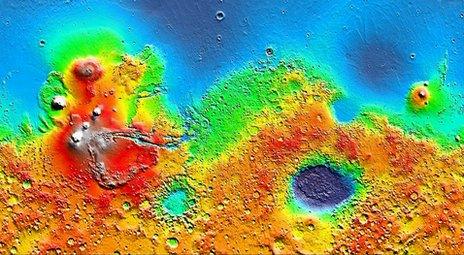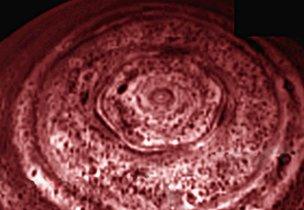Puzzles of our cosmic neighbourhood
- Published
For decades, scientists have been sending robotic probes deep into the Solar System, revealing a diverse and dynamic array of worlds orbiting the Sun.
Unmanned spacecraft have transformed understanding of our cosmic neighbourhood. But this avalanche of data has also thrown up many new questions.
As the 2012 Lunar and Planetary Science Conference gets under way in The Woodlands, Texas, here are just a few of the open questions about the fascinating family of objects that share our celestial postcode.
ARE WE ALONE?

Lakes of liquid water might exist just 3km beneath Europa's surface
From the tubeworms that cluster around hydrothermal vents on the ocean floor, to the bacterial communities eking out an existence in the dry valleys of Antarctica, life on Earth is found in some extreme environments. But what does that say about the prospects for life elsewhere in our Solar System?
Prof Andrew Coates of the Mullard Space Science Laboratory says there is a check-list of requirements that indicate whether a moon or planet could support life. Liquid water is of crucial importance, as is a source of heat, time (for life to evolve) and the right chemical ingredients.
The elements most vital for life are carbon, hydrogen, nitrogen, oxygen, phosphorus and sulphur, which go by the mnemonic CHNOPS. Assuming this shopping list holds true elsewhere in the cosmos, a handful of planets and moons emerge as prime targets in the search for non-terrestrial life in the Solar System.

Geysers on Saturn's moon Enceladus spew water into space
While Mars may have glistened with seas and lakes early on in its history, today its surface is a frozen desert battered by cosmic radiation. A recent study of data from Nasa's Phoenix spacecraft - which investigated the Martian "arctic" in 2008 - suggests the Red Planet's soil is indeed too dry to support microbial life, external. But if pockets of liquid water persists beneath a layer of sub-surface ice on Mars, so might communities of micro-organisms. This idea was given a boost a few years ago when scientists detected methane in the Martian atmosphere (more on this below).
The prospects for extra-terrestrial life might be as good or even better on icy satellites like Jupiter's moon Europa or the saturnian satellite Enceladus. In the 1980s, the Galileo spacecraft detected signs of a liquid water ocean beneath Europa's ice shell. In addition, this ocean seemed to be in contact with the moon's rocky mantle, providing a ready supply of chemical building blocks.
A future mission to Europa might be able to study samples from the ocean without having to drill through tens or hundreds of km of ice. Convection is thought to dredge up ocean water to the surface, and a recent paper in Nature suggests the presence of shallow lakes just 3km below the ice crust. A much smaller ocean might be the source of the water spewed out in geysers from Enceladus' south pole. Water is kept liquid on Europa and Enceladus by "tidal heating", caused by the pull of a planet's gravity.
MYSTERY METHANE

Titan has been described as an early Earth stuck in the deep freeze
Methane has been detected in the Martian atmosphere by Europe's Mars Express probe and by telescopes on Earth. But this poses a problem: the Sun's rays rapidly break this gas down into other molecules, so it cannot have been there for very long. This suggests there must be some source on Mars that continuously "tops up" the atmospheric methane as it is being destroyed.
So where is it coming from? There are several possibilities. Although Mars was once considered geologically "dead", active volcanoes could provide one explanation. A chemical process known as serpentinisation, which can occur deep in the crust, offers another way to make the organic molecule. Another, even more intriguing, option is that microbes generate the gas. A Nasa mission known as Maven (Mars Atmosphere and Volatile EvolutioN) will launch to the Red Planet in 2013 to investigate the source of this methane gas.
A similar problem exists over the methane on Saturn's moon Titan. The moon is shrouded in a dense orange-hued atmosphere, a small but significant proportion of which is methane. As on Mars, UV rays rapidly break it down, and scientists estimate that all the methane could be destroyed in tens of millions of years - a long timescale by our standards, but short compared with the age of the Solar System.
There isn't enough liquid methane on the surface to replenish the atmosphere, which suggests the presence of underground reservoirs. The Huygens probe, which landed on Titan in 2005, showed that the carbon in this methane lacks a tell-tale signature which might point to a biological origin. Instead, it might be stored beneath the surface in a form of methane-rich ice known as clathrate.
How it gets to the surface remains unclear, says Ralph Lorenz, from the Johns Hopkins Applied Physics Laboratory: "Is that methane being continuously replenished from the interior through vents, or a seep - the way radon seeps up through the ground on Earth? Does it come spewing up through geysers, or is a lot released by a volcanic eruption once every million years? We just don't know," he explains.
TWO FACES OF MARS

The contrast between the north and south halves of Mars is striking
The striking contrast between the northern and southern hemispheres of Mars has posed a conundrum ever since it became apparent in images sent back in the 1970s by the Mariner 9 and Viking missions. Geologically young, low-lying plains dominate the northern half of the planet, while the southern half is characterised by old, highland terrain that is pock-marked with craters.
In the 1990s, Nasa's Mars Global Surveyor spacecraft showed that the crust was thicker in the south than it was in the north. Magnetic anomalies are also seen in the southern half of the planet but not the north. But what was the cause?
Some scientists have proposed that an internal process - perhaps convection in the mantle or plate tectonics - could be responsible for Mars' two-faced character. Under the plate tectonics model, the present day boundary between north and south hemispheres marks the ancient plate margin.
However, other groups have long argued that the "Martian dichotomy" resulted from a gargantuan space impact, or even several. Such large collisions would have been quite common in the early Solar System. Indeed, a massive smash-up at around the same time is widely thought to have created Earth's moon.
In 2008, two groups published studies in the journal Nature that support the single impact theory using computer simulations. In one paper, Dr Francis Nimmo and colleagues suggested the northern crust originates from deep mantle rock, external melted by an impact some 100 million years after Mars formed. The collision was powerful enough to send shock waves travelling to the other end of the planet, causing the magnetic anomalies seen there.
In the other paper, external, a team led by Margarita Marinova estimated that an object one-half to two-thirds the size of the Moon, striking at an angle of 30 to 60 degrees could fit the bill.
MAJESTIC RINGS

The unsullied appearance of the rings led some to suppose they were young
Saturn is defined by its vast ring system - a majestic halo that extends 270,000km from one side to the other. The material in the ring is 90% water ice, and ranges in size from tiny grains to boulders a few metres wide. Yet exactly how this colossal structure was created remains an open question.
Astronomers had long thought that the ring system was as ancient as the Solar System - about 4.6 billion years old. But if the rings had been around for a long time, they should have become relatively dirty, due to constant bombardment by meteorites. However, observations showed the icy ring material to be surprisingly bright, and therefore largely untainted by the dust from space rocks. This has led some scientists to the conclusion that the rings are actually much younger.

Scientists want to understand the mechanics of this hexagon-shaped storm on Saturn
But this view is complicated by observations that the icy material is simultaneously being broken apart and clumping together, recycling the dust throughout the ring system and making it seem brighter than it might otherwise look. Dr Linda Spilker from Nasa's Jet Propulsion Laboratory says that, in addition to young versus old there is a third possibility - a hybrid theory. She says the most massive rings, such as the B ring, could be relatively old, while more tenuous rings formed later.
As to what the rings formed from, scientists think they could be the result of a comet breaking up near Saturn's or a moon several hundred km in diameter that was destroyed after being dragged inwards by the planet's gravity. Planetary scientist Robin Canup proposes another explanation: that a large moon was stripped of its icy mantle as it collided with Saturn, and that this ice provided the material for the ring.
Up until the end of its mission in 2017, the Cassini space probe will take more accurate measurements of the rings' mass; combining these with estimates of how often meteorites hit the rings could yield fresh insights into their age. Dr Spilker says Cassini will also shed light on two other Saturn conundrums - the uncertain length of a saturnian day, and the mechanics of a hexagon-shaped storm at the planet's north pole.
Paul.Rincon-INTERNET@bbc.co.uk
- Published6 October 2010